HI6005 Research Paper: Management, Organisations, Global Environment
VerifiedAdded on 2024/07/22
|9
|1613
|354
Report
AI Summary
This report presents a research paper focusing on organizational culture and motivation within a global environment, specifically addressing activities from weeks 3 and 10 of the HI6005 course. Week 3's activity explores the definition of organizational culture, highlighting the varying perspectives influenced by individual backgrounds and values, with a preference expressed for clan culture emphasizing collaboration and human resource development. Week 10 delves into Hertzberg's two-factor theory of motivation, differentiating between hygiene factors and motivators, and proposes strategies for motivating employees in the fast-food industry through job enrichment and recognition. The paper concludes by emphasizing the importance of understanding and applying these concepts to foster a positive and productive work environment. Desklib provides access to this and other solved assignments.
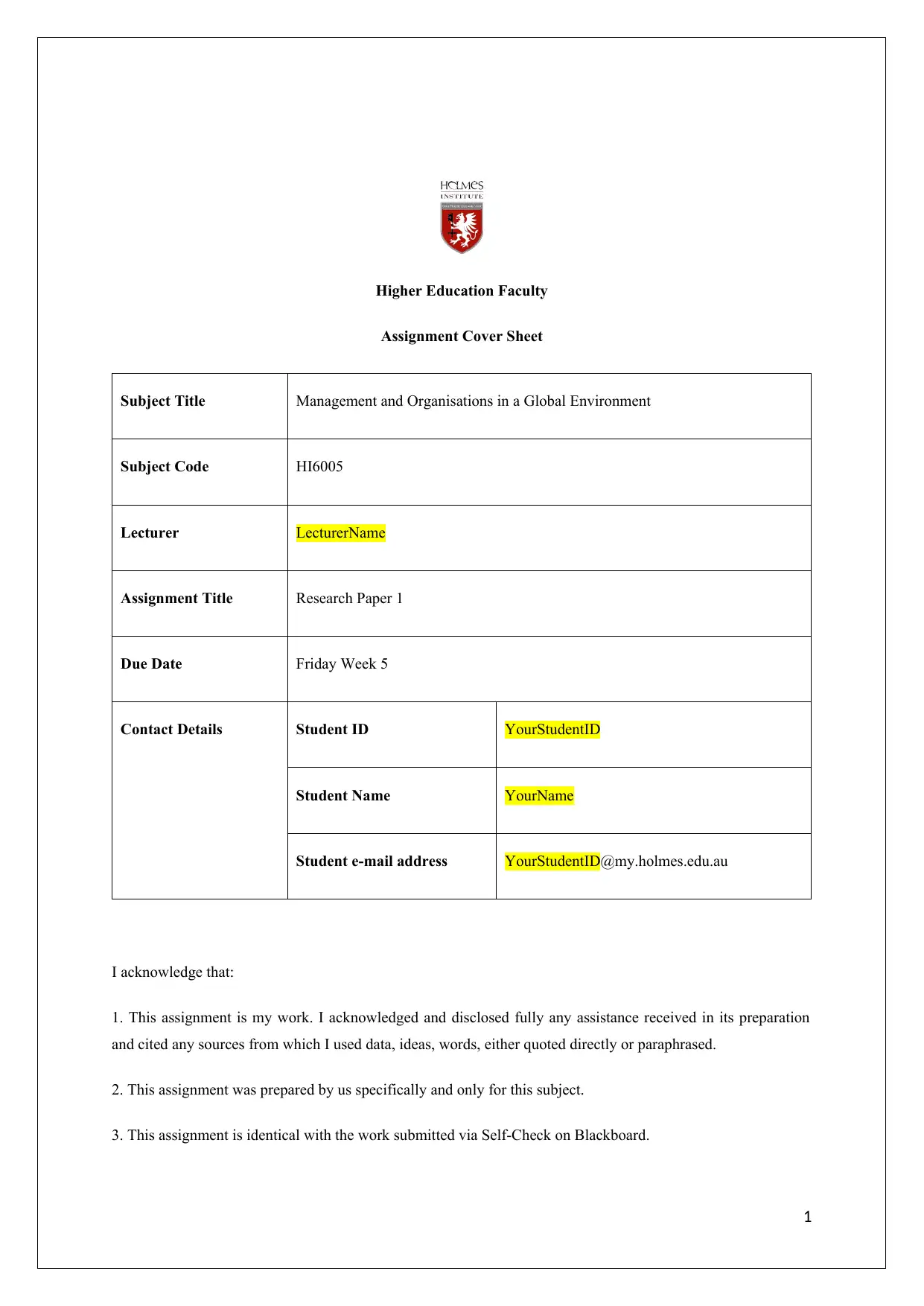
Higher Education Faculty
Assignment Cover Sheet
Subject Title Management and Organisations in a Global Environment
Subject Code HI6005
Lecturer LecturerName
Assignment Title Research Paper 1
Due Date Friday Week 5
Contact Details Student ID YourStudentID
Student Name YourName
Student e-mail address YourStudentID@my.holmes.edu.au
I acknowledge that:
1. This assignment is my work. I acknowledged and disclosed fully any assistance received in its preparation
and cited any sources from which I used data, ideas, words, either quoted directly or paraphrased.
2. This assignment was prepared by us specifically and only for this subject.
3. This assignment is identical with the work submitted via Self-Check on Blackboard.
1
Assignment Cover Sheet
Subject Title Management and Organisations in a Global Environment
Subject Code HI6005
Lecturer LecturerName
Assignment Title Research Paper 1
Due Date Friday Week 5
Contact Details Student ID YourStudentID
Student Name YourName
Student e-mail address YourStudentID@my.holmes.edu.au
I acknowledge that:
1. This assignment is my work. I acknowledged and disclosed fully any assistance received in its preparation
and cited any sources from which I used data, ideas, words, either quoted directly or paraphrased.
2. This assignment was prepared by us specifically and only for this subject.
3. This assignment is identical with the work submitted via Self-Check on Blackboard.
1
Paraphrase This Document
Need a fresh take? Get an instant paraphrase of this document with our AI Paraphraser
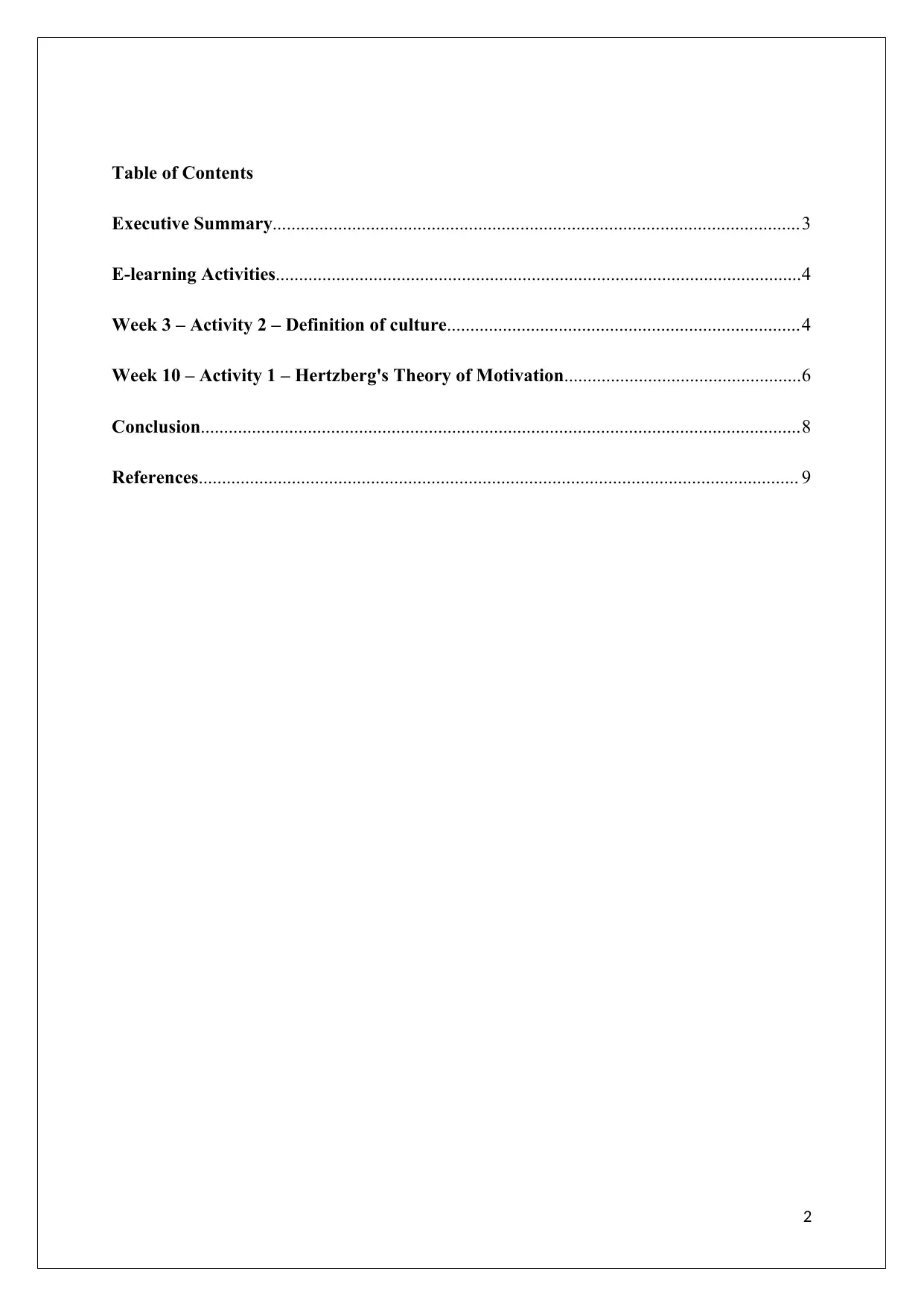
Table of Contents
Executive Summary.................................................................................................................3
E-learning Activities.................................................................................................................4
Week 3 – Activity 2 – Definition of culture............................................................................4
Week 10 – Activity 1 – Hertzberg's Theory of Motivation...................................................6
Conclusion.................................................................................................................................8
References................................................................................................................................. 9
2
Executive Summary.................................................................................................................3
E-learning Activities.................................................................................................................4
Week 3 – Activity 2 – Definition of culture............................................................................4
Week 10 – Activity 1 – Hertzberg's Theory of Motivation...................................................6
Conclusion.................................................................................................................................8
References................................................................................................................................. 9
2
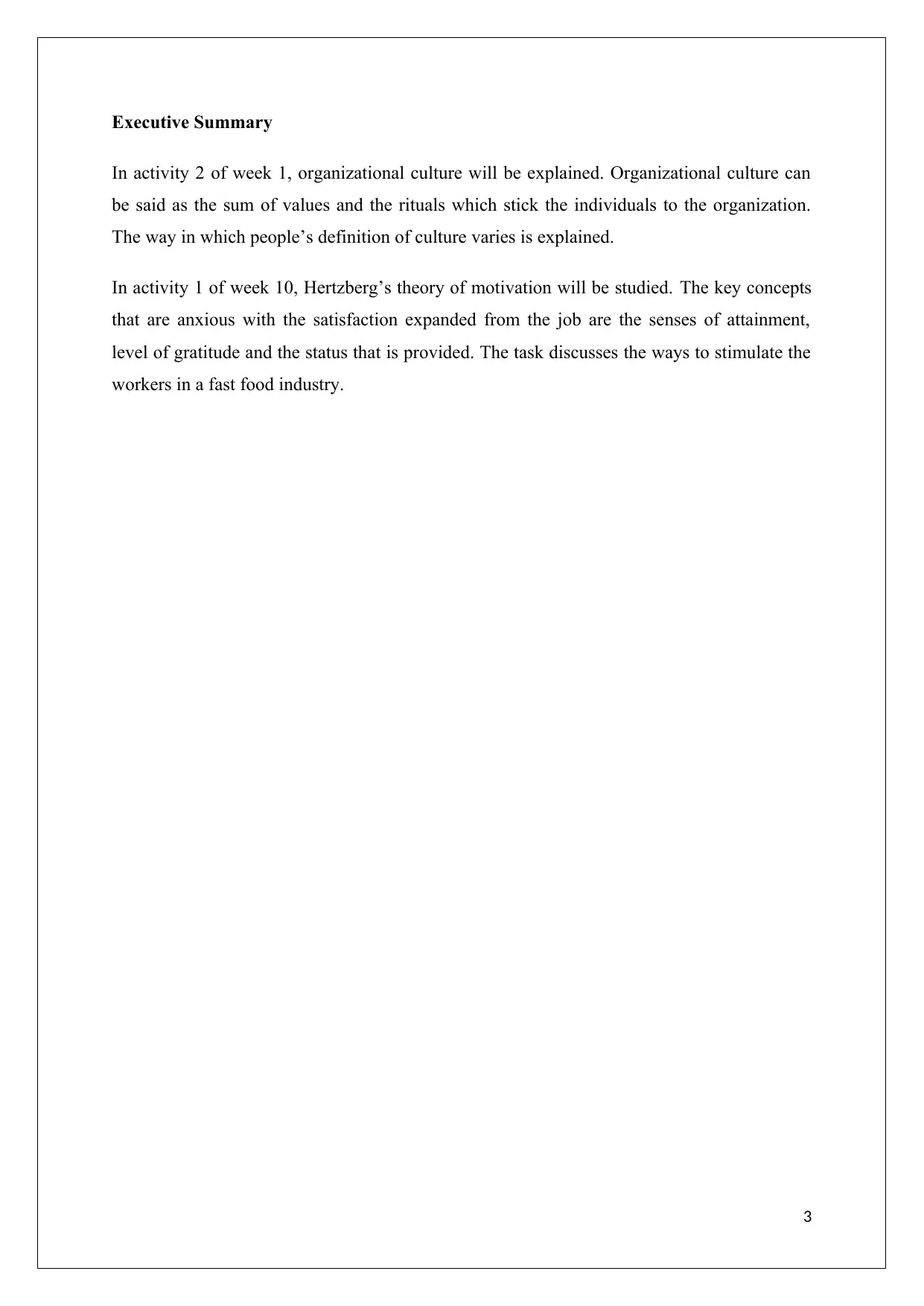
Executive Summary
In activity 2 of week 1, organizational culture will be explained. Organizational culture can
be said as the sum of values and the rituals which stick the individuals to the organization.
The way in which people’s definition of culture varies is explained.
In activity 1 of week 10, Hertzberg’s theory of motivation will be studied. The key concepts
that are anxious with the satisfaction expanded from the job are the senses of attainment,
level of gratitude and the status that is provided. The task discusses the ways to stimulate the
workers in a fast food industry.
3
In activity 2 of week 1, organizational culture will be explained. Organizational culture can
be said as the sum of values and the rituals which stick the individuals to the organization.
The way in which people’s definition of culture varies is explained.
In activity 1 of week 10, Hertzberg’s theory of motivation will be studied. The key concepts
that are anxious with the satisfaction expanded from the job are the senses of attainment,
level of gratitude and the status that is provided. The task discusses the ways to stimulate the
workers in a fast food industry.
3
⊘ This is a preview!⊘
Do you want full access?
Subscribe today to unlock all pages.

Trusted by 1+ million students worldwide
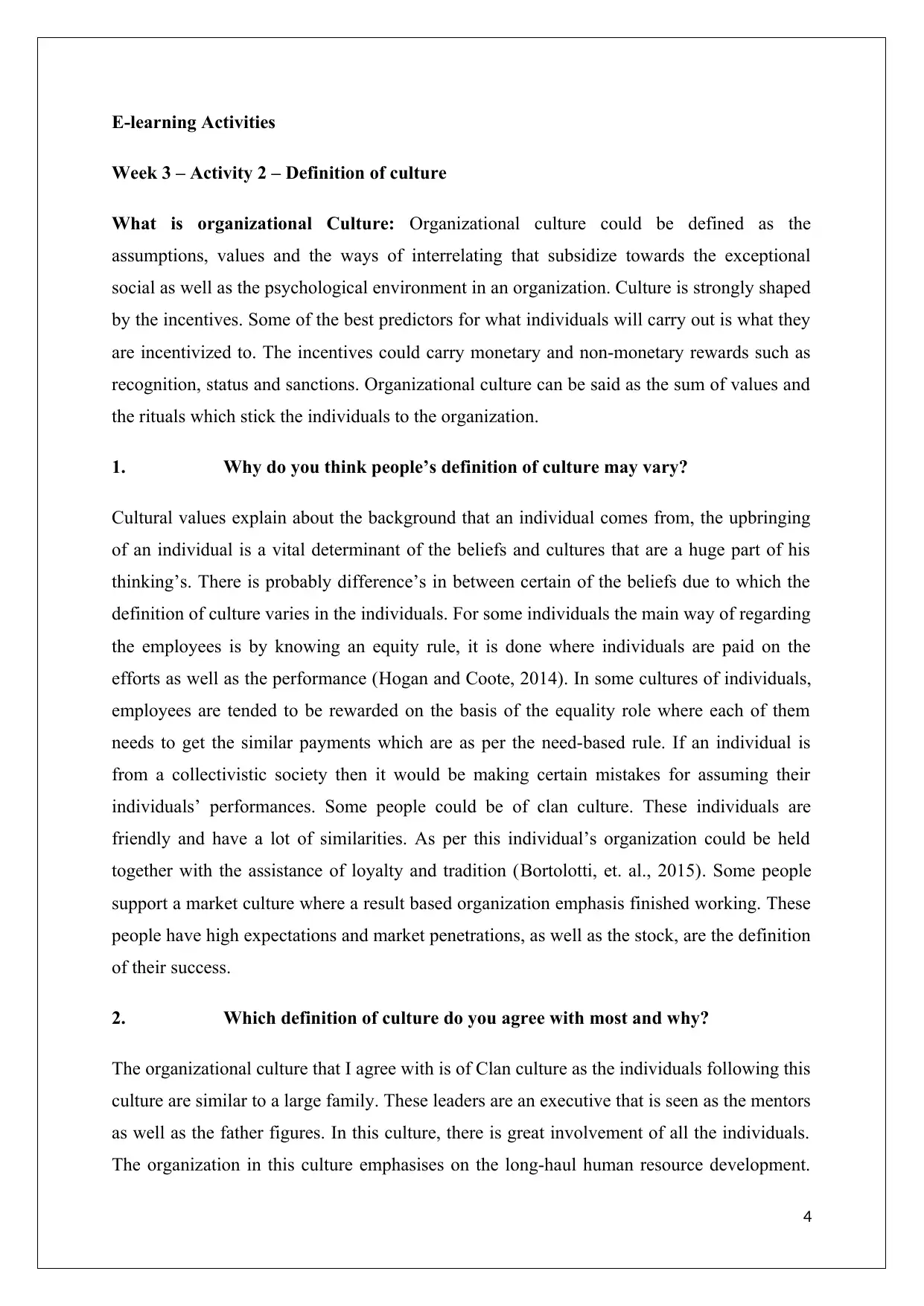
E-learning Activities
Week 3 – Activity 2 – Definition of culture
What is organizational Culture: Organizational culture could be defined as the
assumptions, values and the ways of interrelating that subsidize towards the exceptional
social as well as the psychological environment in an organization. Culture is strongly shaped
by the incentives. Some of the best predictors for what individuals will carry out is what they
are incentivized to. The incentives could carry monetary and non-monetary rewards such as
recognition, status and sanctions. Organizational culture can be said as the sum of values and
the rituals which stick the individuals to the organization.
1. Why do you think people’s definition of culture may vary?
Cultural values explain about the background that an individual comes from, the upbringing
of an individual is a vital determinant of the beliefs and cultures that are a huge part of his
thinking’s. There is probably difference’s in between certain of the beliefs due to which the
definition of culture varies in the individuals. For some individuals the main way of regarding
the employees is by knowing an equity rule, it is done where individuals are paid on the
efforts as well as the performance (Hogan and Coote, 2014). In some cultures of individuals,
employees are tended to be rewarded on the basis of the equality role where each of them
needs to get the similar payments which are as per the need-based rule. If an individual is
from a collectivistic society then it would be making certain mistakes for assuming their
individuals’ performances. Some people could be of clan culture. These individuals are
friendly and have a lot of similarities. As per this individual’s organization could be held
together with the assistance of loyalty and tradition (Bortolotti, et. al., 2015). Some people
support a market culture where a result based organization emphasis finished working. These
people have high expectations and market penetrations, as well as the stock, are the definition
of their success.
2. Which definition of culture do you agree with most and why?
The organizational culture that I agree with is of Clan culture as the individuals following this
culture are similar to a large family. These leaders are an executive that is seen as the mentors
as well as the father figures. In this culture, there is great involvement of all the individuals.
The organization in this culture emphasises on the long-haul human resource development.
4
Week 3 – Activity 2 – Definition of culture
What is organizational Culture: Organizational culture could be defined as the
assumptions, values and the ways of interrelating that subsidize towards the exceptional
social as well as the psychological environment in an organization. Culture is strongly shaped
by the incentives. Some of the best predictors for what individuals will carry out is what they
are incentivized to. The incentives could carry monetary and non-monetary rewards such as
recognition, status and sanctions. Organizational culture can be said as the sum of values and
the rituals which stick the individuals to the organization.
1. Why do you think people’s definition of culture may vary?
Cultural values explain about the background that an individual comes from, the upbringing
of an individual is a vital determinant of the beliefs and cultures that are a huge part of his
thinking’s. There is probably difference’s in between certain of the beliefs due to which the
definition of culture varies in the individuals. For some individuals the main way of regarding
the employees is by knowing an equity rule, it is done where individuals are paid on the
efforts as well as the performance (Hogan and Coote, 2014). In some cultures of individuals,
employees are tended to be rewarded on the basis of the equality role where each of them
needs to get the similar payments which are as per the need-based rule. If an individual is
from a collectivistic society then it would be making certain mistakes for assuming their
individuals’ performances. Some people could be of clan culture. These individuals are
friendly and have a lot of similarities. As per this individual’s organization could be held
together with the assistance of loyalty and tradition (Bortolotti, et. al., 2015). Some people
support a market culture where a result based organization emphasis finished working. These
people have high expectations and market penetrations, as well as the stock, are the definition
of their success.
2. Which definition of culture do you agree with most and why?
The organizational culture that I agree with is of Clan culture as the individuals following this
culture are similar to a large family. These leaders are an executive that is seen as the mentors
as well as the father figures. In this culture, there is great involvement of all the individuals.
The organization in this culture emphasises on the long-haul human resource development.
4
Paraphrase This Document
Need a fresh take? Get an instant paraphrase of this document with our AI Paraphraser
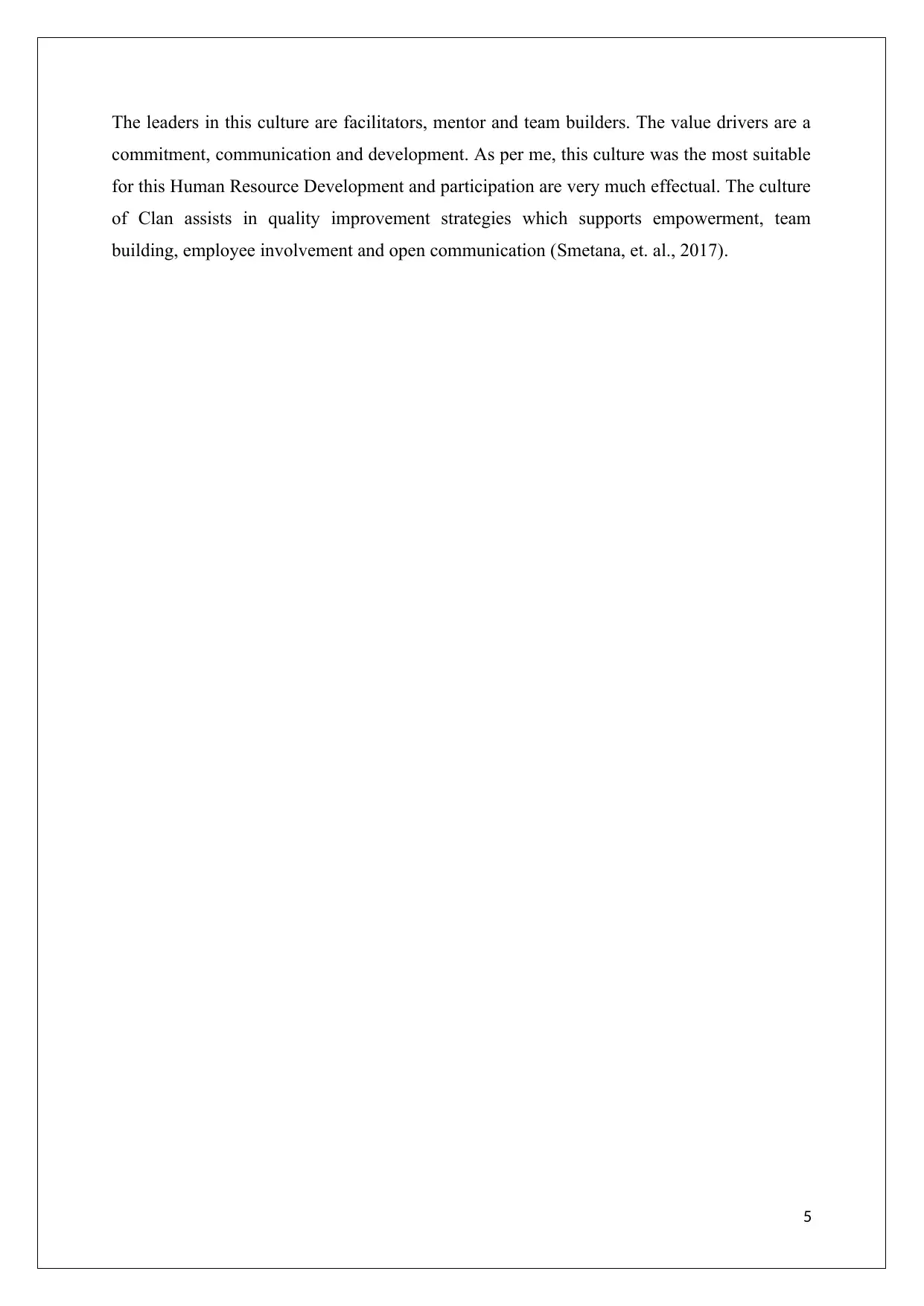
The leaders in this culture are facilitators, mentor and team builders. The value drivers are a
commitment, communication and development. As per me, this culture was the most suitable
for this Human Resource Development and participation are very much effectual. The culture
of Clan assists in quality improvement strategies which supports empowerment, team
building, employee involvement and open communication (Smetana, et. al., 2017).
5
commitment, communication and development. As per me, this culture was the most suitable
for this Human Resource Development and participation are very much effectual. The culture
of Clan assists in quality improvement strategies which supports empowerment, team
building, employee involvement and open communication (Smetana, et. al., 2017).
5
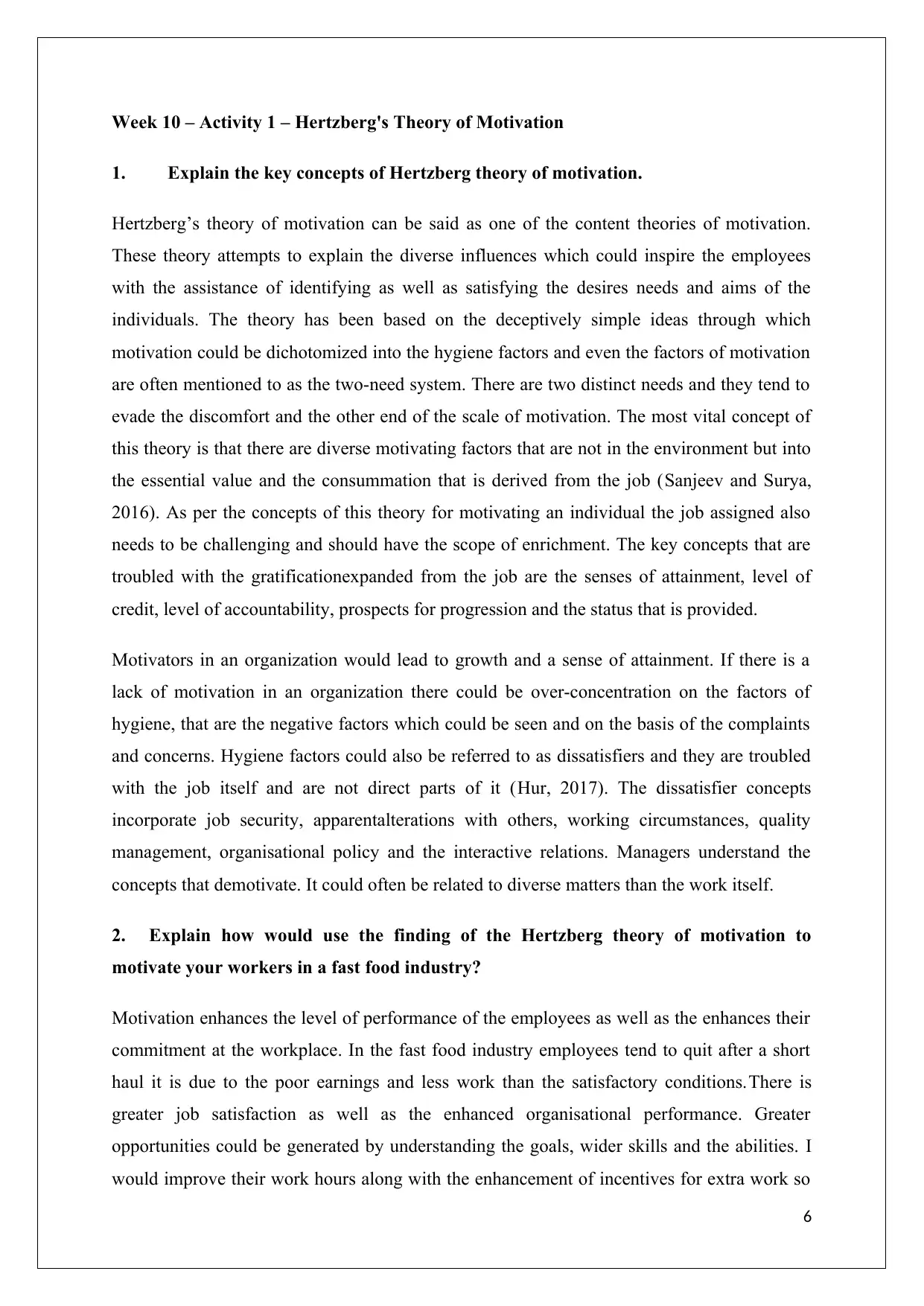
Week 10 – Activity 1 – Hertzberg's Theory of Motivation
1. Explain the key concepts of Hertzberg theory of motivation.
Hertzberg’s theory of motivation can be said as one of the content theories of motivation.
These theory attempts to explain the diverse influences which could inspire the employees
with the assistance of identifying as well as satisfying the desires needs and aims of the
individuals. The theory has been based on the deceptively simple ideas through which
motivation could be dichotomized into the hygiene factors and even the factors of motivation
are often mentioned to as the two-need system. There are two distinct needs and they tend to
evade the discomfort and the other end of the scale of motivation. The most vital concept of
this theory is that there are diverse motivating factors that are not in the environment but into
the essential value and the consummation that is derived from the job (Sanjeev and Surya,
2016). As per the concepts of this theory for motivating an individual the job assigned also
needs to be challenging and should have the scope of enrichment. The key concepts that are
troubled with the gratificationexpanded from the job are the senses of attainment, level of
credit, level of accountability, prospects for progression and the status that is provided.
Motivators in an organization would lead to growth and a sense of attainment. If there is a
lack of motivation in an organization there could be over-concentration on the factors of
hygiene, that are the negative factors which could be seen and on the basis of the complaints
and concerns. Hygiene factors could also be referred to as dissatisfiers and they are troubled
with the job itself and are not direct parts of it (Hur, 2017). The dissatisfier concepts
incorporate job security, apparentalterations with others, working circumstances, quality
management, organisational policy and the interactive relations. Managers understand the
concepts that demotivate. It could often be related to diverse matters than the work itself.
2. Explain how would use the finding of the Hertzberg theory of motivation to
motivate your workers in a fast food industry?
Motivation enhances the level of performance of the employees as well as the enhances their
commitment at the workplace. In the fast food industry employees tend to quit after a short
haul it is due to the poor earnings and less work than the satisfactory conditions.There is
greater job satisfaction as well as the enhanced organisational performance. Greater
opportunities could be generated by understanding the goals, wider skills and the abilities. I
would improve their work hours along with the enhancement of incentives for extra work so
6
1. Explain the key concepts of Hertzberg theory of motivation.
Hertzberg’s theory of motivation can be said as one of the content theories of motivation.
These theory attempts to explain the diverse influences which could inspire the employees
with the assistance of identifying as well as satisfying the desires needs and aims of the
individuals. The theory has been based on the deceptively simple ideas through which
motivation could be dichotomized into the hygiene factors and even the factors of motivation
are often mentioned to as the two-need system. There are two distinct needs and they tend to
evade the discomfort and the other end of the scale of motivation. The most vital concept of
this theory is that there are diverse motivating factors that are not in the environment but into
the essential value and the consummation that is derived from the job (Sanjeev and Surya,
2016). As per the concepts of this theory for motivating an individual the job assigned also
needs to be challenging and should have the scope of enrichment. The key concepts that are
troubled with the gratificationexpanded from the job are the senses of attainment, level of
credit, level of accountability, prospects for progression and the status that is provided.
Motivators in an organization would lead to growth and a sense of attainment. If there is a
lack of motivation in an organization there could be over-concentration on the factors of
hygiene, that are the negative factors which could be seen and on the basis of the complaints
and concerns. Hygiene factors could also be referred to as dissatisfiers and they are troubled
with the job itself and are not direct parts of it (Hur, 2017). The dissatisfier concepts
incorporate job security, apparentalterations with others, working circumstances, quality
management, organisational policy and the interactive relations. Managers understand the
concepts that demotivate. It could often be related to diverse matters than the work itself.
2. Explain how would use the finding of the Hertzberg theory of motivation to
motivate your workers in a fast food industry?
Motivation enhances the level of performance of the employees as well as the enhances their
commitment at the workplace. In the fast food industry employees tend to quit after a short
haul it is due to the poor earnings and less work than the satisfactory conditions.There is
greater job satisfaction as well as the enhanced organisational performance. Greater
opportunities could be generated by understanding the goals, wider skills and the abilities. I
would improve their work hours along with the enhancement of incentives for extra work so
6
⊘ This is a preview!⊘
Do you want full access?
Subscribe today to unlock all pages.

Trusted by 1+ million students worldwide
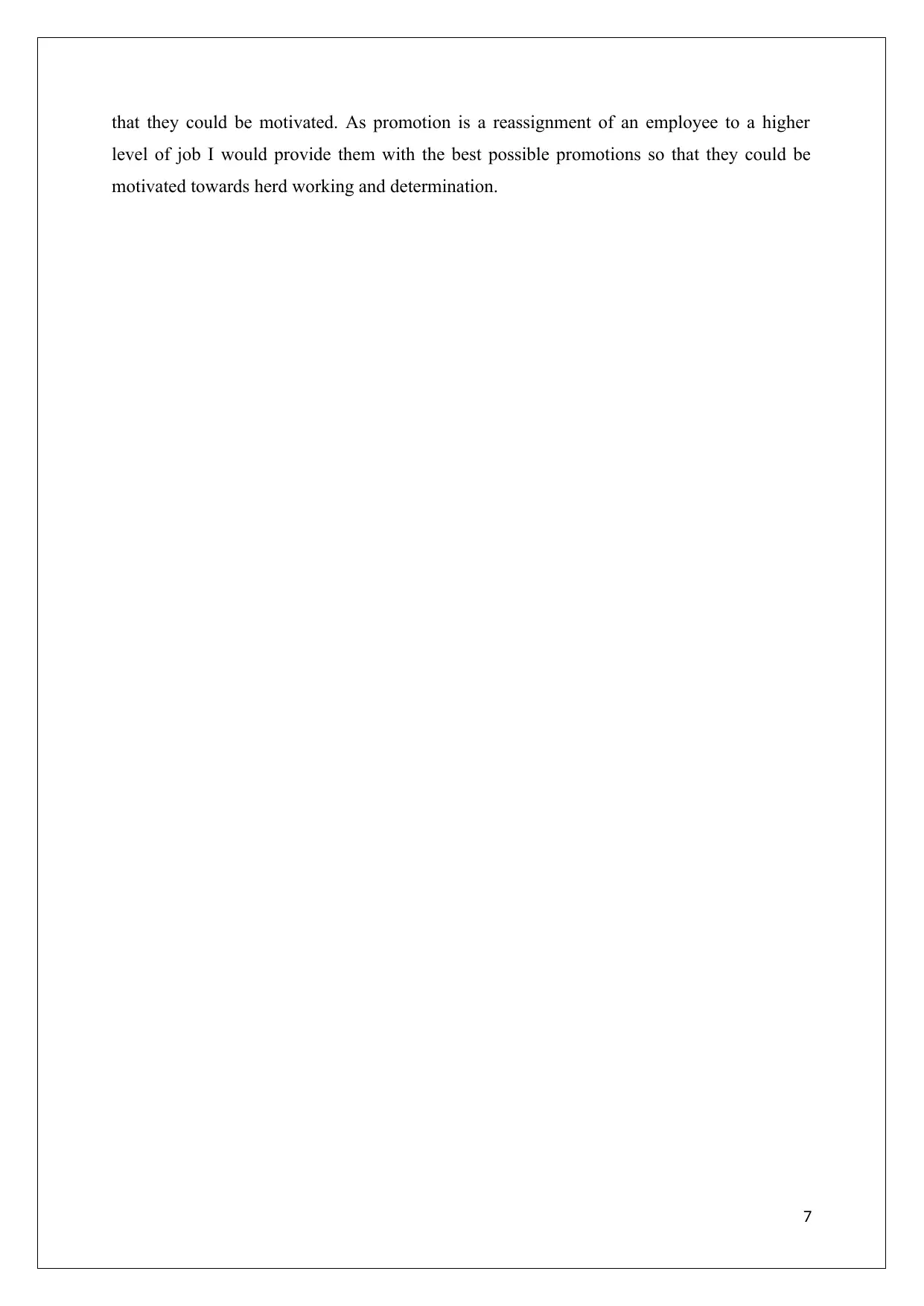
that they could be motivated. As promotion is a reassignment of an employee to a higher
level of job I would provide them with the best possible promotions so that they could be
motivated towards herd working and determination.
7
level of job I would provide them with the best possible promotions so that they could be
motivated towards herd working and determination.
7
Paraphrase This Document
Need a fresh take? Get an instant paraphrase of this document with our AI Paraphraser
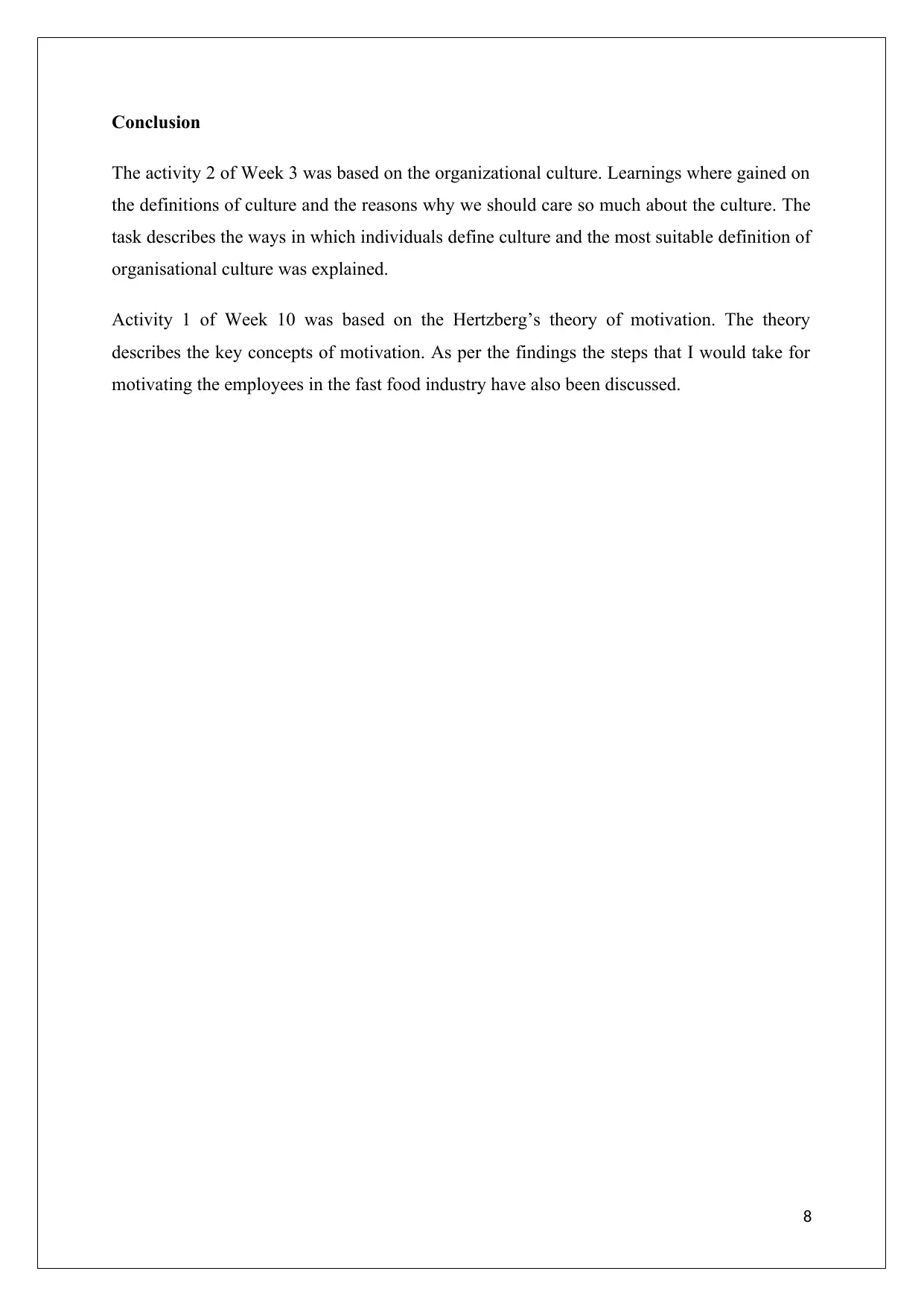
Conclusion
The activity 2 of Week 3 was based on the organizational culture. Learnings where gained on
the definitions of culture and the reasons why we should care so much about the culture. The
task describes the ways in which individuals define culture and the most suitable definition of
organisational culture was explained.
Activity 1 of Week 10 was based on the Hertzberg’s theory of motivation. The theory
describes the key concepts of motivation. As per the findings the steps that I would take for
motivating the employees in the fast food industry have also been discussed.
8
The activity 2 of Week 3 was based on the organizational culture. Learnings where gained on
the definitions of culture and the reasons why we should care so much about the culture. The
task describes the ways in which individuals define culture and the most suitable definition of
organisational culture was explained.
Activity 1 of Week 10 was based on the Hertzberg’s theory of motivation. The theory
describes the key concepts of motivation. As per the findings the steps that I would take for
motivating the employees in the fast food industry have also been discussed.
8
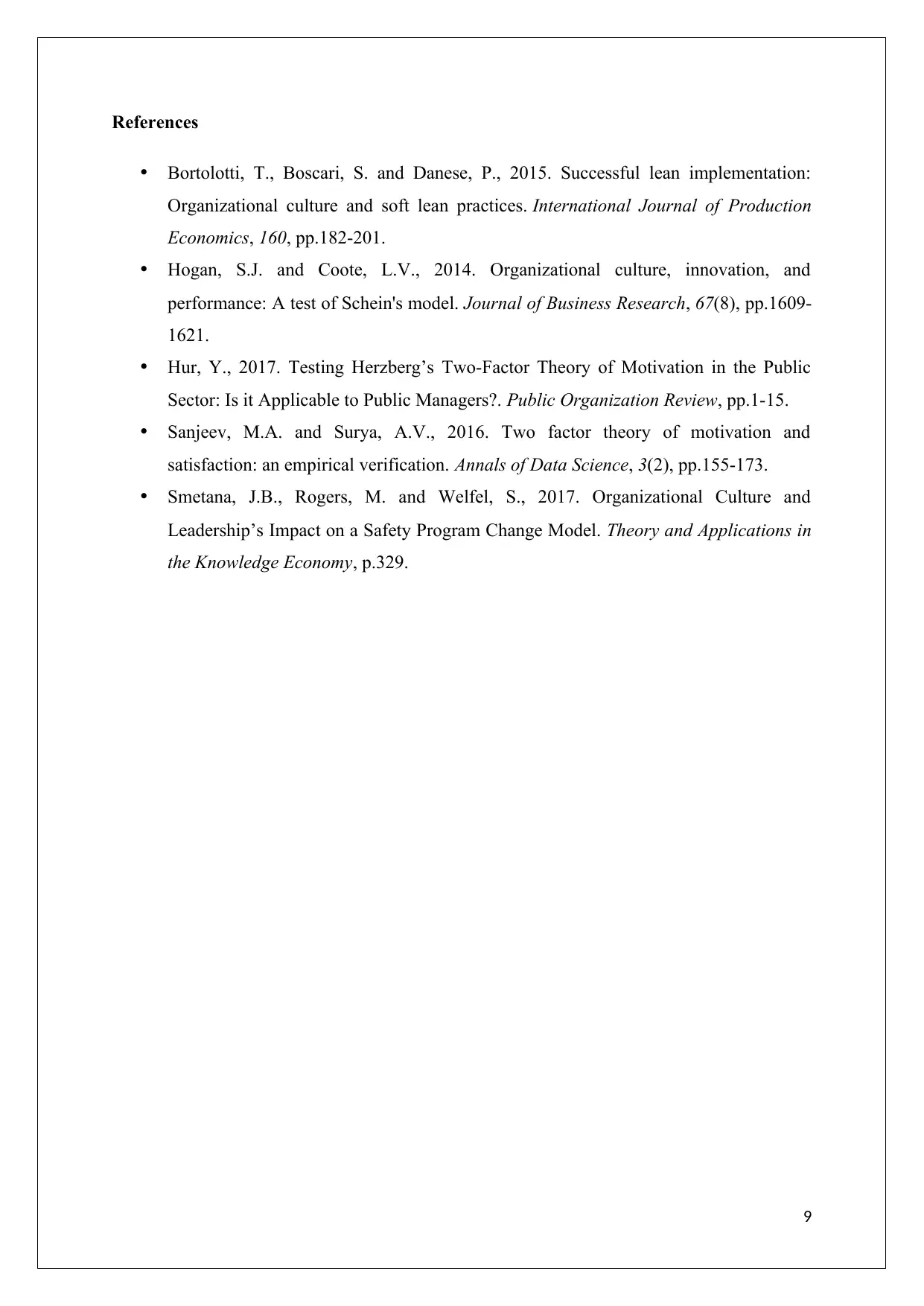
References
Bortolotti, T., Boscari, S. and Danese, P., 2015. Successful lean implementation:
Organizational culture and soft lean practices. International Journal of Production
Economics, 160, pp.182-201.
Hogan, S.J. and Coote, L.V., 2014. Organizational culture, innovation, and
performance: A test of Schein's model. Journal of Business Research, 67(8), pp.1609-
1621.
Hur, Y., 2017. Testing Herzberg’s Two-Factor Theory of Motivation in the Public
Sector: Is it Applicable to Public Managers?. Public Organization Review, pp.1-15.
Sanjeev, M.A. and Surya, A.V., 2016. Two factor theory of motivation and
satisfaction: an empirical verification. Annals of Data Science, 3(2), pp.155-173.
Smetana, J.B., Rogers, M. and Welfel, S., 2017. Organizational Culture and
Leadership’s Impact on a Safety Program Change Model. Theory and Applications in
the Knowledge Economy, p.329.
9
Bortolotti, T., Boscari, S. and Danese, P., 2015. Successful lean implementation:
Organizational culture and soft lean practices. International Journal of Production
Economics, 160, pp.182-201.
Hogan, S.J. and Coote, L.V., 2014. Organizational culture, innovation, and
performance: A test of Schein's model. Journal of Business Research, 67(8), pp.1609-
1621.
Hur, Y., 2017. Testing Herzberg’s Two-Factor Theory of Motivation in the Public
Sector: Is it Applicable to Public Managers?. Public Organization Review, pp.1-15.
Sanjeev, M.A. and Surya, A.V., 2016. Two factor theory of motivation and
satisfaction: an empirical verification. Annals of Data Science, 3(2), pp.155-173.
Smetana, J.B., Rogers, M. and Welfel, S., 2017. Organizational Culture and
Leadership’s Impact on a Safety Program Change Model. Theory and Applications in
the Knowledge Economy, p.329.
9
⊘ This is a preview!⊘
Do you want full access?
Subscribe today to unlock all pages.

Trusted by 1+ million students worldwide
1 out of 9
Related Documents
Your All-in-One AI-Powered Toolkit for Academic Success.
+13062052269
info@desklib.com
Available 24*7 on WhatsApp / Email
![[object Object]](/_next/static/media/star-bottom.7253800d.svg)
Unlock your academic potential
Copyright © 2020–2025 A2Z Services. All Rights Reserved. Developed and managed by ZUCOL.




